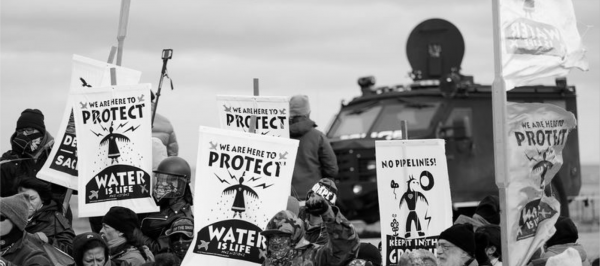We Must Stand With Standing Rock
November 4, 2016
A live Facebook video feed from protester Atsa E’sha Hoferer, on Oct. 27 showed a long line of protesters face-to-face with police in riot gear attempting to push the protesters back. Police shouted, “You need to move to the South Camp or you will be arrested.” Protesters shouted back, “This is your water too” and began chanting “Water is Life.” When the protesters would not move, the police threw tear gas into the crowd and forcibly pushed them to the ground, marching them to the south camp. Protesters were given little choice but to meet their coercive demands, but remained face-to-face with police, walking backwards to the south camp while chanting in solidarity. The video has garnered over 1.1 million views and counting.
The protests against the North Dakota Access Pipeline have been going on since January of last year, yet was largely ignored in the mainstream media until Oct. 27. That day, militarized local law enforcement used trucks, buses and military Humvees to move protesters, arresting approximately 141 people for “illegal protesting.” The local police used pepper spray, bean-bag bullets, tear gas and sound cannons on nearby protesters. Officials reported that some protesters responded by starting two tire-fires and lobbed two Molotov cocktails at law enforcement. One woman shot a .38 caliber towards a group of officers. Recently, a no-fly zone and no-drone zone have been issued over the area.
Why is it that the mainstream media is only now covering the protest against the Dakota Access Pipeline (DAPL)?
Perhaps the recent attention is due to how the government’s handling of the protest vastly contradicts American values. It is just one example in a much longer history of Native American oppression in the U.S. At best, this protest exposes the government’s treatment of Native American people for what it is: a constant system of checks and balances to assure that those who have the highest claim to U.S. land have their voices, and therefore their influence, silenced. Months of police violence against nonviolent unarmed protesters has been going on at Standing Rock, and it wasn’t until protesters fought back that mainstream news outlets began to cover it.
For those unfamiliar with the DAPL, it is a projected 1,172 mile pipeline stretching from North Dakota to Illinois. Along this route, many sacred Native American burial sites would be disrupted, in addition to residents living with the risk of unforeseen environmental damage as in the recent Pennsylvania pipeline burst from Sunoco, the same company trying to build the DAPL). Sioux Tribe members and other members of over 100 different tribes, nearby constituents, high profile journalists, federal officials and celebrities have voiced their opposition to the pipeline, with many even going to North Dakota to protest on the front lines.
There has been a great deal of legal action on this issue. The Sioux Tribe sued the Army Corps for attempting to fast-track building the DAPL, to which the Corps counter-sued tribe members for blocking construction. Tribal members and allied-protesters alike do not deny blocking construction, but they argue that they have a right to the land under two federal treaties. A federal judge denied the Sioux Tribe’s request, but after three federal agencies joined together to call for a halt to construction, the construction on Corps-owned land was temporarily put on hold. Construction was allowed to continue on land that the developer privately owned, which incited the ongoing protests.
Largely due to the shrewd use of social media by online protesters, the Standing Rock pipeline protest exposes the U.S.’s militarized police force, and ultimately, its emerging police state. Over 200 protesters have been arrested over the course of this ordeal. The thousands who have yet to be have been attacked by dogs from the DAPL company, have had military-grade sound cannons used against them, and have been shot with rubber bullets, had their water supplies cut off, threatened with shotguns at prayer sites, undergone constant aerial surveillance, and youth and elders have been pepper-sprayed —well before the retaliation seen tonight. Unarmed protesters who have been arrested have dealt with excessive force, intimidation at the point of a gun, strip searches and issues with receiving bail.
Many have posed comparisons to protesters of the Civil Rights Movement. While there are stark similarities between then and now, it seems that struggle between the police and the people has only gotten more contentious since. Military and police are separate entities with separate purposes. Police are meant to protect and serve within their communities, while the military fights a foreign enemy. When our country has a militarized police force, home becomes their battlefield, and we become their target.
Martin Luther King Jr. once said, “Riots are the voice of the unheard.” While responding to violence with violence is never the answer, we cannot let the actions of a few people who reached their breaking point take away from the deeper implications behind this protest at Standing Rock. They are fighting to preserve life—our life. If that’s not a cause worth fighting for, then I’m not sure what is.










